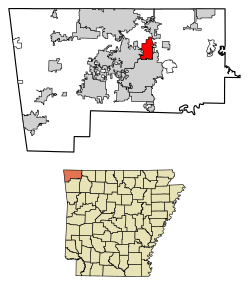Little Flock, Arkansas
Little Flock is a city in Benton County, Arkansas, United States. The population was 2,585 at the 2010 census. It is a small, rural community known as one of the safest cities in Arkansas. It is part of the Fayetteville–Springdale–Rogers, AR-MO Metropolitan Statistical Area.
Little Flock, Arkansas | |
|---|---|
 Location of Little Flock in Benton County, Arkansas. | |
| Coordinates: 36°23′17″N 94°8′12″W | |
| Country | United States |
| State | Arkansas |
| County | Benton |
| Area | |
| • Total | 7.51 sq mi (19.46 km2) |
| • Land | 7.51 sq mi (19.45 km2) |
| • Water | 0.00 sq mi (0.00 km2) |
| Elevation | 1,194 ft (364 m) |
| Population (2010) | |
| • Total | 2,585 |
| • Estimate (2019)[2] | 2,786 |
| • Density | 370.97/sq mi (143.23/km2) |
| Time zone | UTC-6 (Central (CST)) |
| • Summer (DST) | UTC-5 (CDT) |
| FIPS code | 05-40120 |
| GNIS feature ID | 1669456 |
| Website | http://cityoflittleflock.com/ |
Geography
Little Flock is located at 36°23′17″N 94°8′12″W (36.387919, -94.136694).[3]
According to the United States Census Bureau, the city has a total area of 7.6 square miles (20 km2), all land.
Demographics
| Historical population | |||
|---|---|---|---|
| Census | Pop. | %± | |
| 1980 | 663 | — | |
| 1990 | 944 | 42.4% | |
| 2000 | 2,585 | 173.8% | |
| 2010 | 2,585 | 0.0% | |
| Est. 2019 | 2,786 | [2] | 7.8% |
| U.S. Decennial Census[4] | |||
As of the census[5] of 2010, there were 2,585 people, in 1,126 households with 99.0% of the population in households. The racial makeup of the population was 76.1% non-Hispanic white, 2.5% black or African American, 1.9% Native American, 4.3% Asian, 0.3% Pacific Islander, 0.1% non-Hispanic from some other race, 3.5% from two or more races and 12.3% Hispanic or Latino.[6]
In 2000 there were 1,016 households, and 685 families residing in the city. The population density was 341.9 people per square mile (132.0/km2). There were 1,083 housing units at an average density of 143.3/sq mi (55.3/km2). The racial makeup of the city was 83.21% White, 0.89% Black or African American, 1.70% Native American, 5.65% Asian, 0.43% Pacific Islander, 5.88% from other races, and 2.24% from two or more races. 15.98% of the population were Hispanic or Latino of any race.
There were 1,016 households, out of which 37.3% had children under the age of 18 living with them, 54.7% were married couples living together, 9.1% had a female householder with no husband present, and 32.5% were non-families. 26.9% of all households were made up of individuals, and 3.4% had someone living alone who was 65 years of age or older. The average household size was 2.52 and the average family size was 3.06.
In the city, the population was spread out, with 27.7% under the age of 18, 16.3% from 18 to 24, 33.2% from 25 to 44, 16.5% from 45 to 64, and 6.4% who were 65 years of age or older. The median age was 28 years. For every 100 females, there were 109.3 males. For every 100 females age 18 and over, there were 107.1 males.
The median income for a household in the city was $32,768, and the median income for a family was $38,456. Males had a median income of $28,661 versus $21,708 for females. The per capita income for the city was $16,447. About 10.2% of families and 13.1% of the population were below the poverty line, including 17.4% of those under age 18 and 3.4% of those age 65 or over.
Education
Public education for elementary and secondary students is provided by Bentonville School District, which leads to graduation from Bentonville High School.
References
- "2019 U.S. Gazetteer Files". United States Census Bureau. Retrieved June 30, 2020.
- "Population and Housing Unit Estimates". United States Census Bureau. May 24, 2020. Retrieved May 27, 2020.
- "US Gazetteer files: 2010, 2000, and 1990". United States Census Bureau. 2011-02-12. Retrieved 2011-04-23.
- "Census of Population and Housing". Census.gov. Retrieved June 4, 2015.
- "U.S. Census website". United States Census Bureau. Retrieved 2008-01-31.
- 2010 general profile of population and housing characteristics of Little Flock from the US census
